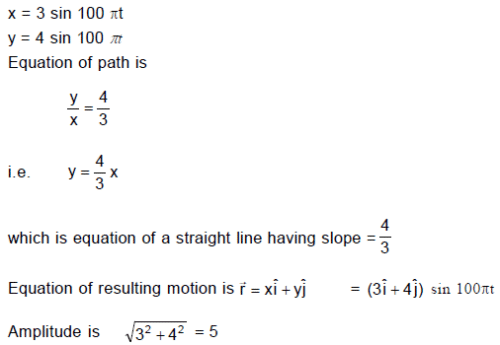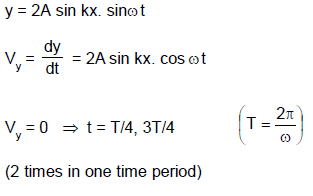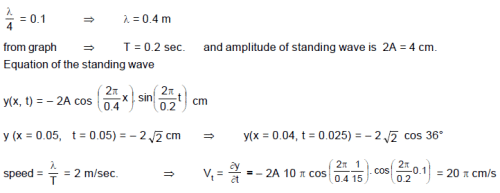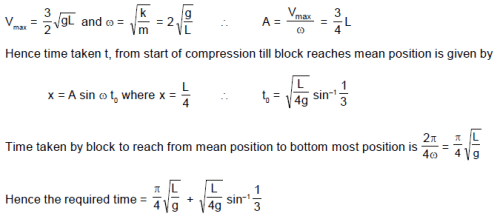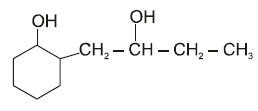JEE Advanced Test- 9 - JEE MCQ
30 Questions MCQ Test Mock Tests for JEE Main and Advanced 2025 - JEE Advanced Test- 9
A particle performs SHM with a time period T and amplitude 'a'. The magnitude of average velocity of the particle over the time interval during which it travels a distance a/T from the extreme position is :
A simple pendulum 50 cm long is suspended from the roof of a cart accelerating in the horizontal direction with constant acceleration √3 g m/s2. The period of small oscillations of the pendulum about its equilibrium position is (g = π2 m/s2) :
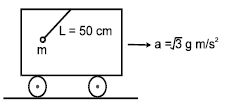

| 1 Crore+ students have signed up on EduRev. Have you? Download the App |
A particle is subjected to two simple harmonic motions along x and y directions according to, x = 3 sin 100 πt; y = 4 sin 100 πt :
When a wave pulse traveling in a string is reflected from a rigid wall to which string is tied as shown in figure. For this situation two statements are given below :
(1) The reflected pulse will be in same orientation of incident pulse due to a phase change of p radians
(2) During reflection the wall exert a force on string in upward direction
For the above given two statements choose the correct option given below :
The equation of displacement due to a sound wave is s = s0 sin2 (ω t - kx). If the bulk modulus of the medium is B, then the equation of pressure variation due to that sound is :
A point source of power 50π watts is producing sound waves of frequency 1875Hz. The velocity of sound is 330m/s, atmospheric pressure is 1.0 x 105 Nm-2, density of air is 1.0 kgm-3. Then pressure amplitude at r = m from the point source is (using π = 22/7) :
An organ pipe of length L is open at one end and closed at other end. The wavelengths of the three lowest resonating frequencies that can be produced by this pipe are :
A wire having a linear mass density 5.0 ´ 10-3 kg/m is stretched between two rigid supports with a tension of 450 N. The wire resonates at a frequency of 420 Hz. The next higher frequency at which the same wire resonates is 480 Hz. The length of the wire is :
A particle is executing SHM between points -Xm and Xm, as shown in figure-I. The velocity V(t) of the particle is partially graphed and shown in figure-II. Two points A and B corresponding to time t1 and time t2 respectively are marked on the V(t) curve :

For a certain transverse standing wave on a long string, an antinode is formed at x = 0 and next to it, a node is formed at x = 0.10 m. the displacement y(t) of the string particle at x = 0 is shown in figure.
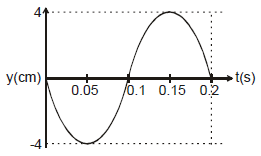
A wave pulse moving in the positive x-direction along the x-axis is represented by the wave function where x and y are in centimeters and t is in seconds. Then
Statement-1 : A particle is moving along x-axis. The resultant force F acting on it is given by F = – ax – b. Where a and b are both positive constants. The motion of this particle is not SHM.
Statement-2 : In SHM resultant force must be proportional to the displacement from mean position.
Statement-1 : Two waves moving in a uniform string having uniform tension cannot have different velocities.
Statement-2 : Elastic and inertial properties of string are same for all waves in same string. Moreover speed of wave in a string depends on its elastic and inertial properties only.
Statement-1 : In a small segment of string carrying sinusoidal wave, total energy is conserved.
Statement-2 : Every small part moves in SHM and in SHM total energy is conserved.
Statement-1 : When two vibrating tuning forks having frequencies 256 Hz and 512 Hz are held near each other, beats cannot be heard.
Statement-2 : The principle of superposition of waves is valid only if the frequencies of both the interfering waves are equal or nearly equal.
A small block of mass m is fixed at upper end of a massless vertical spring of spring constant K = and natural length '10L'. The lower end of spring is free and is at a height L from fixed horizontal floor as shown. The spring is initially unstressed and the spring-block system is released from rest in the shown position.
Q. At the instant speed of block is maximum, the magnitude of force exerted by spring on the block is :
A small block of mass m is fixed at upper end of a massless vertical spring of spring constant K = and natural length '10L'. The lower end of spring is free and is at a height L from fixed horizontal floor as shown. The spring is initially unstressed and the spring-block system is released from rest in the shown position.
Q. As the block is coming down, the maximum speed attained by the block is :
A small block of mass m is fixed at upper end of a massless vertical spring of spring constant K = and natural length '10L'. The lower end of spring is free and is at a height L from fixed horizontal floor as shown. The spring is initially unstressed and the spring-block system is released from rest in the shown position.
Q. Till the block reaches its lowest position for the first time, the time duration for which the spring remains compressed is :
There is a point source of sound placed at (0, h) as shown in figure. Two detectors D1 and D2 are placed at positions (D,d/2) and (D,– d/2) respectively. Take h < < D. The source emitted a sound pulse at a certain time. Assuming velocity of sound in the surrounding medium is v.
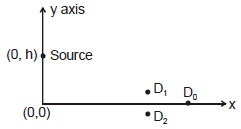
Q. The time gap between the recordings made by the detectors will approximately be :
There is a point source of sound placed at (0, h) as shown in figure. Two detectors D1 and D2 are placed at positions (D,d/2) and (D,– d/2) respectively. Take h < < D. The source emitted a sound pulse at a certain time. Assuming velocity of sound in the surrounding medium is v.

Q. If the source emits continuous waves, and the pressures recorded by the two detectors are superposed at every instant in detector D0 (which is equidistant from D1 & D2), the resultant pressure amplitude will be maximum if the minimum frequency of the source is :
There is a point source of sound placed at (0, h) as shown in figure. Two detectors D1 and D2 are placed at positions (D,d/2) and (D,– d/2) respectively. Take h < < D. The source emitted a sound pulse at a certain time. Assuming velocity of sound in the surrounding medium is v.

Q. If the source is shifted slightly towards positive X direction. The minimum frequency required for the super posed pressure amplitude (detected at D0) to be maximum will (as compared to the answer in above question) :
Match the statements in column-I with the statements in column-II.
Column-I Column-II
(A) A tight string is fixed at both ends and (p) At the middle, antinode is formed
sustaining standing wave in odd harmonic
(B) A tight string is fixed at one end and (q) At the middle, node is formed
free at the other end in even harmonic
(C) Standing wave is formed in an open organ (r) At the middle, neither node nor
pipe. End correction is not negligible. antinode is formed
(D) Standing wave is formed in a closed (s) Phase difference between SHMs of any
organ pipe. End correction is not negligible. two particles will be either p or zero.
(t) The displacement of the particle in the middle is always non zero.
Acidic strength of marked hydrogen of following compound in decreasing order is

A hydrocarbon (P) on ozonolysis in presence of zinc gives only one dicarbonyl compound, which gives both Tollen’s and iodoform test. Identify the structure of (P).
Consider the true/false of the following statements:
S1: The most stable resonating structure of p-nitrophenol (not having aromatic ring) is .
S2 : In all C–O bonds are of equal length.
S3 : CH3COONa is more resonance stabilised than the protonated acid CH3COOH.
S4 : Benzene ring is more electron dense in phenol than phenoxide.
A hydrocarbon ‘X’ C7H10 is catalytically hydrogenated to C7H14 ‘Y’. 'Y' gives six monochloro products after photochemical chlorination. The structure of 'X' is -
|
357 docs|148 tests
|
|
357 docs|148 tests
|



